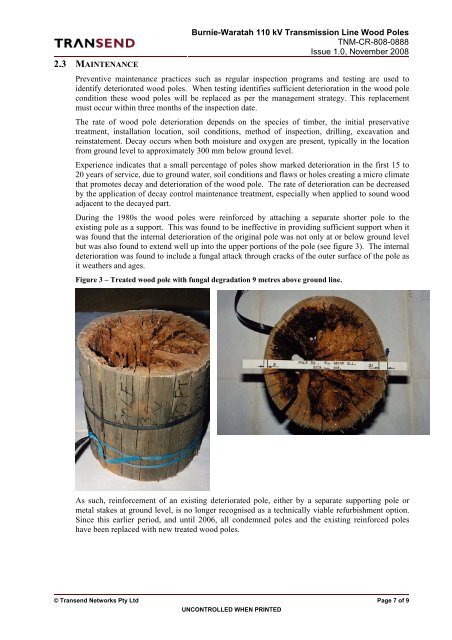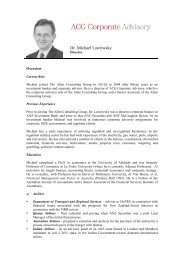Transend - Appendix 5 Renewal capital expenditure - Australian ...
Transend - Appendix 5 Renewal capital expenditure - Australian ...
Transend - Appendix 5 Renewal capital expenditure - Australian ...
Create successful ePaper yourself
Turn your PDF publications into a flip-book with our unique Google optimized e-Paper software.
2.3 MAINTENANCE<br />
Burnie-Waratah 110 kV Transmission Line Wood Poles<br />
TNM-CR-808-0888<br />
Issue 1.0, November 2008<br />
Preventive maintenance practices such as regular inspection programs and testing are used to<br />
identify deteriorated wood poles. When testing identifies sufficient deterioration in the wood pole<br />
condition these wood poles will be replaced as per the management strategy. This replacement<br />
must occur within three months of the inspection date.<br />
The rate of wood pole deterioration depends on the species of timber, the initial preservative<br />
treatment, installation location, soil conditions, method of inspection, drilling, excavation and<br />
reinstatement. Decay occurs when both moisture and oxygen are present, typically in the location<br />
from ground level to approximately 300 mm below ground level.<br />
Experience indicates that a small percentage of poles show marked deterioration in the first 15 to<br />
20 years of service, due to ground water, soil conditions and flaws or holes creating a micro climate<br />
that promotes decay and deterioration of the wood pole. The rate of deterioration can be decreased<br />
by the application of decay control maintenance treatment, especially when applied to sound wood<br />
adjacent to the decayed part.<br />
During the 1980s the wood poles were reinforced by attaching a separate shorter pole to the<br />
existing pole as a support. This was found to be ineffective in providing sufficient support when it<br />
was found that the internal deterioration of the original pole was not only at or below ground level<br />
but was also found to extend well up into the upper portions of the pole (see figure 3). The internal<br />
deterioration was found to include a fungal attack through cracks of the outer surface of the pole as<br />
it weathers and ages.<br />
Figure 3 – Treated wood pole with fungal degradation 9 metres above ground line.<br />
As such, reinforcement of an existing deteriorated pole, either by a separate supporting pole or<br />
metal stakes at ground level, is no longer recognised as a technically viable refurbishment option.<br />
Since this earlier period, and until 2006, all condemned poles and the existing reinforced poles<br />
have been replaced with new treated wood poles.<br />
© <strong>Transend</strong> Networks Pty Ltd Page 7 of 9<br />
UNCONTROLLED WHEN PRINTED







